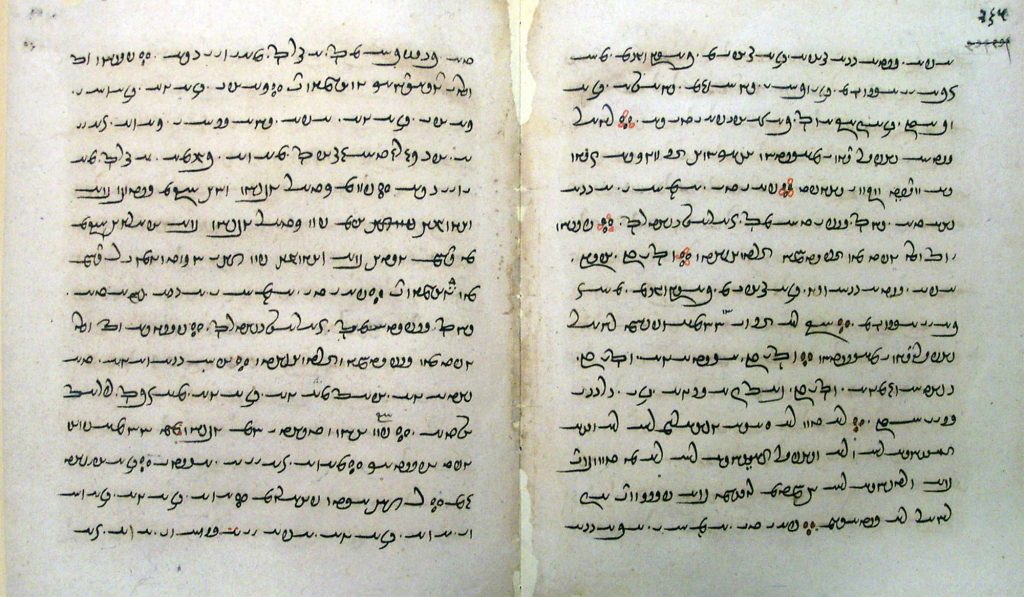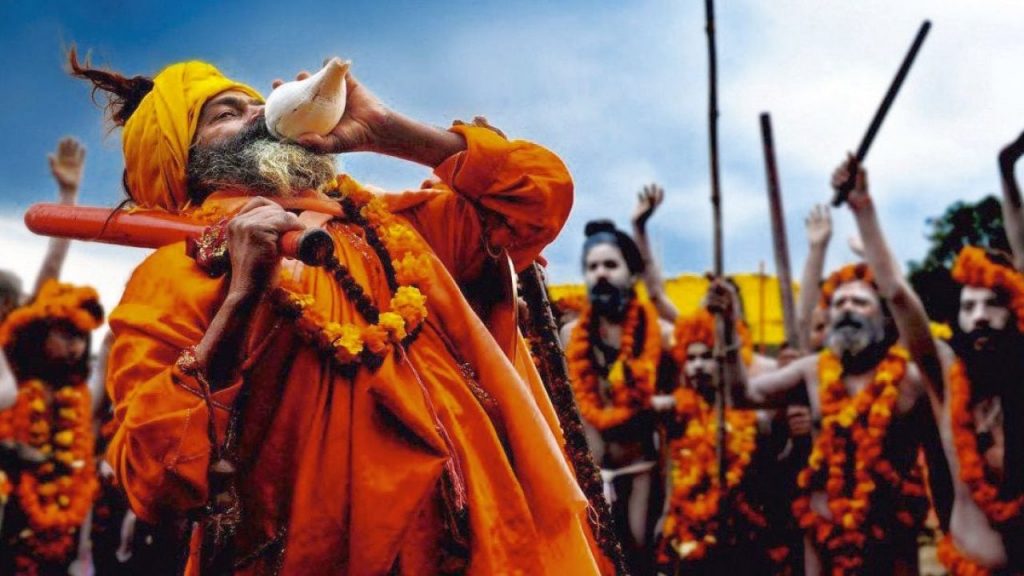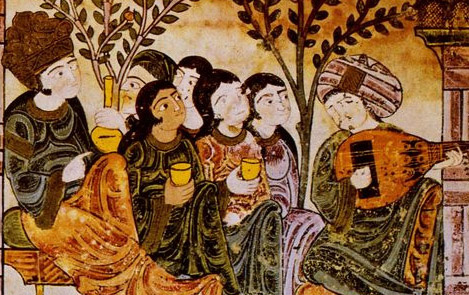Hinduism
Antiquity of the word “Hindu”
Published
5 years agoon
By
Vedic Tribe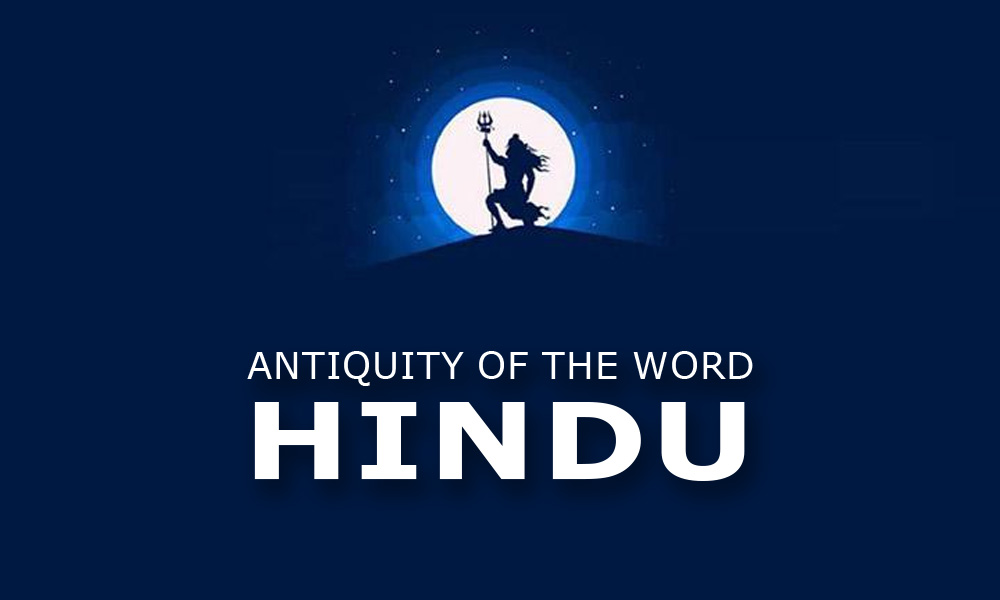
Here is an eye-opening article about the antiquity of the word “Hindu.” The communist historians of India and the Western Indologists claim that the word “Hindu” was invented by the Arabs in the 8th century and its origins lay in the Persian practice of replacing “S” with “H”. However, many inscriptions over a thousand years older than this period have used the word ”Hindu” or its derivatives. Also, the origin of the word most certainly lies in the Saurashtra region of Gujarat in India, not in Persia.
What I found particularly interesting was that Prophet Mohammed’s uncle Omar-bin-e-Hassham had composed a poem in praise of Lord Shiva, a copy of which can be found in the Makhtab-e-Sultania library in Istanbul, Turkey. This rang a bell in my mind. There are many websites which claim that Kaba was an ancient Shiva temple. I don’t know what to make of these claims, but the fact that Prophet Mohammed’s uncle had written an ode to Lord Shiva is certainly stunning.
Antiquity and Origin of the Term ‘Hindu’
The anti-Hindu historians like Romila Thapar and D.N. Jha have opined that the word ‘Hindu’ was given currency by the Arabs in the 8th century. They however, do not explain the basis of their conclusion nor do they cite any evidence in support of their claim. Even Arab Muslim writers do not make such an extravagant claim.
Another theory propounded by European writers is that the word ‘Hindu’ is a Persian corruption of ‘Sindhu’ resulting from the Persian practice of replacing ‘S’ with ‘H’. Even here, no evidence is cited. In fact the word Persia itself contains ‘S’ which should have become ‘Perhia’ if this theory was correct.
The present paper examines the above two theories in the light of epigraphic and literary evidence available from Persian, Indian, Greek, Chinese and Arabic sources. The evidence appears to support the conclusion that ‘Hindu’ like ‘Sindhu’, has been in use since the Vedic age and that although ‘Hindu’ is a modified form of ‘Sindhu’, its origin lies in the Saurashtran practice of pronouncing ‘H’ in place of ‘S’.

Epigraphic Evidence
The Hamadan, Persepolis and Naqsh-I-Rustam Inscriptions of Persian monarch Darius mention a people ‘Hidu’ as included in his empire. These inscriptions are dated between 520-485 B.C. This fact establishes that the term ‘Hi(n)du’ was current more than 500 years before Christ.
Xerexes, successor of Darius, in his inscriptions at Persepolis, gives names of countries under his rule. The list includes ‘Hidu’. Xerexes was ruling between 485-465 B.C. On a tomb in Persepolis, in another inscription assigned to Artaxerexes (404-395 B.C.), there are three figures above which are inscribed ‘iyam Qataguviya’ (this is Satygidian), ‘iyam Ga(n)dariya’ (this is Gandhara) and ‘iyam Hi(n)duviya’ (this is Hi(n)du). The Asokan inscriptions (3rd century B.C.) repeatedly use expressions like ‘Hida’ for ‘India’ and ‘Hida loka’ for ‘Indian nation’.
‘Hida’ and its derivative forms are used more than 70 times in the Ashokan inscriptions. For instance in the Jaugadha, separate rock edict II, the lines 3 & 4, read:
All men are my people. I desire for my people that they may be provided with all welfare and happiness. I desire for my people, including the people of Hind and beyond and I desire for all men.
The Edict further, says in lines 7 & 8 Dhamma may be followed and the people of Hind and beyond may be served.
The Ashokan inscriptions establish the antiquity of the name ‘Hind’ for India to at least third century B.C.
In Persepolis Pahlvi inscriptions of Shahpur II (310 A.D.) the king has the titles shakanshah hind shakastan u tuxaristan dabiran dabir, “king of Shakastan, minister of ministers of Hind Shakastan and Tukharistan.”
The epigraphic evidence from the Achaemenid, Ashokan and Sasanian Pahlvi records puts a question mark on the theory about the term ‘Hindu’ having originated in Arab usage in the 8th century A.D. Literary evidence takes the antiquity of the word ‘Hindu’ back to at least 1000 B.C. and possibly 5000 B.C.
Evidence from Pahlvi Avesta
In the Avesta, Hapta-Hindu is used for Sanskrit Sapta-Sindhu, the Avesta being dated variously between 5000-1000 B.C. This indicates that the term ‘Hindu’ is as old as the word ‘Sindhu.’ Sindhu is a Vedik term used in the Rigveda. And therefore, ‘Hindu’ is as ancient as the Rigveda.
In the Avestan Gatha ‘Shatir’, 163rd Verse speaks of the visit of Veda Vyas to the court of Gustashp and in the presence of Zorashtra, Veda Vyas introduces himself saying ‘man marde am Hind jijad.’ (I am man born in ‘Hind.’) Veda Vyas was an elder contemporary of Shri Krishna (3100 B.C.). Greek Usage
The Greek term ‘Indoi’ is a softened form of ‘Hindu’ where the initial ‘H’ was dropped as the Greek alphabet has no aspirate. This term ‘Indoi’ was used in Greek literature by Hekataeus (late 6th century B.C.) and Herodotus (early 5th century B.C.), thus establishing that the Greeks were using this derivative of ‘Hindu’ as early as 6th century B.C.
‘Hindu’ in Sanskrit Literature
Another doubt created by the modern day anglicized historian is that the term ‘Hindu’ is not found used in Sanskrit literature. This misconception can be dispelled by quoting from Sanskrit works15 : Meru tantra (es#rU=) (4th to 6th century A.D.), a Shaiva text, comments on ‘Hindu’.
Hindu is one who discards the mean and the ignoble.
The same idea is expressed in Shabda Kalpadruma.
Brihaspati Agam says,
Starting from Himalaya up to Indu waters is this God-created country Hindustan
Parijat Haran Natak describes Hindu as, Hindu is one who with penance washes one’s sins and evil thoughts and with arms destroys one’s enemies.
Madhava Digvijaya states, One who meditates on Omkar as the primeal sound, believes in karma & reincarnation, has reverence for the cow, who is devoted to Bharat, and abhors evil, is deserving of being called Hindu.
Vriddha Smriti defines Hindu as, One who abhors the mean and the ignoble, and is of noblebearing, who reveres the Veda, the cow, and the deity, is a Hindu.
Similarly other Sanskrit works which use the term ‘Hindu’ are, Kalika Puran, Bhavishya Puran, Adbhut Kosh, Medini Kosh, Ram Kosh etc. Even Kalidas has used a derivative form ‘Haindava.’
‘Hindu’ and ‘Sindhu’
Another theory says that ‘Hindu’ originated from the Persian practice of replacing ‘S’ with ‘H’. This does not seem to be true is evident from the fact that Sindh has not become Hind and both Sindh and Hind exist in Persian as well as Arabic.
The inscriptions of Darius and Xerexes which describe India as Hi(n)du, also use the term ‘Sugd’ for Sogdiana. This ‘Sugd’ should have become ‘Hugd’ as per this theory. The Pahlvi inscription of Shahpur II, uses ‘S’ in Shakastan and Tuxaristan.
But it cannot be denied that Hindu is a form of Sindhu. It needs to be realised that this change from S to H is common in Saurashtra where Sorath becomes Horath, Somnath becomes Homnath and so on. The form Hindu is therefore, likely to have come from Saurashtra.
It should also be noted that as per Nirukta rules of grammar, in the Vedik language, replacement of S with H is permitted
The Hebrew Bible
The Hebrew bible uses ‘Hodu’ for India, which is a Judaic form of ‘Hindu’. The Hebrew Bible (Old Testament) is considered earlier than 300 B.C. Today’s Hebrew spoken in Israel also uses Hodu for India.
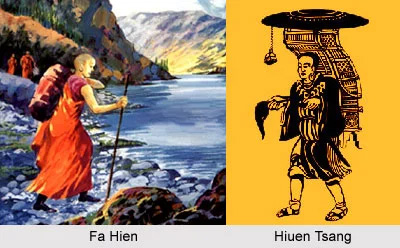
The Chinese Testimony
The Chinese used the term ‘Hien-tu’ for ‘Hindu’ about 100 B.C.11 While describing movements of the Sai-Wang (100 B.C.), the Chinese annals state that the Sai-Wang went towards the South and passing Hien-tu reached Ki-Pin.
Later Chinese travellers Fa-Hien (5th century A.D.) and Huen-Tsang (7th century A.D.) use a slightly modified term ‘Yintu’ but the affinity to ‘Hindu’ is still retained. This term ‘Yintu’ continues to be used till today
Pre-Islamic Arabic Literature
Sair-ul-Okul is an anthology of ancient Arabic poetry available in the Turkish library Makhtab-e-Sultania in Istanbul. In this anthology is included a poem by Prophet Mohammed’s uncle Omar–bin-e-Hassham. The poem is in praise of Mahadev (Shiva), and uses ‘Hind’ for India and ‘Hindu’ for Indians. Some verses are quoted below:
Wa Abaloha ajabu armeeman Mahadevo Manojail ilamuddin minhum wa sayattaru
If but once one worships Mahadev with devotion, One will attain the ultimate salvation.
Wa sahabi Kay yam feema Kamil Hinda e Yauman, Wa Yakulam na latabahan foeennak Tawajjaru.
(Oh Lord grant me but one day’s sojourn in Hind, Where one can attain spiritual bliss.)
Massayare akhalakan hasanan Kullahum, Najumam aja at Summa gabul Hindu.
(But one pilgrimage there gets one all merit, And the company of great Hindu saints.)
The same anthology has another poem by Labi-bin-e Akhtab bin-e Turfa who is dated 2300 years before Mohammed i.e. 1700 B.C. This poem also uses ‘Hind’ for India and ‘Hindu’ for Indian. The poem also mentions the four Vedas Sama, Yajur, Rig and Athar. This poem is quoted on columns in the Laxmi Narayan Mandir in New Delhi, popularly known as Birla Mandir (Temple)
Some verses are as follows:
Aya muwarekal araj yushaiya noha minar Hinda e, wa aradakallha manyonaifail jikaratun. (Oh the Divine land of Hind, blessed art thou, thou art chosen land showered with divine knowledge.)
Wahalatjali Yatun ainana sahabi akhatun jikra, Wahajayahi yonajjalur rasu minal Hindatun. (That celetial knowledge shines with such brilliance, Through the words of Hindu saints in fourfold abundance.)
Yakuloonallaha ya ahlal araf alameen kullahum, fattabe-u jikaratul Veda bukkun malam yonajjaylatun. (God enjoins on all, follow with devotion, path shown by Veda with divine percept.)
Wahowa alamus Sama wal Yajur minallahay Tanajeelan, Fa e noma ya akhigo mutibayan Yobasshariyona jatun. (Overflowing with knowledge are Sama and Yajur for Man, Brothers, follow the path which guides you to salvation.)
Wa isa nain huma Rig Athar nasahin ka Khuwatun, Wa asanat Ala-udan wabowa masha e ratun (Also the two Rig and Athar(va) teach us fraternity, taking shelter under their lusture, dispels darkness.)
You may like
-


Seven Vows and Steps (pheras) of Hindu Wedding explained
-


Atithi Devo Bhava meaning in Hinduism and India
-


Navaratri: The Nine Divine Nights of Maa Durga!
-


Significance of Bilva Leaf – Why is it dear to Lord shiva?
-


Concept of Time and Creation (‘Brahma Srishti’) in Padma Purana
-


Karma Yoga – Yog Through Selfless Actions
Hinduism
Significance of Bilva Leaf – Why is it dear to Lord shiva?
Published
5 years agoon
March 12, 2021By
Vedic Tribe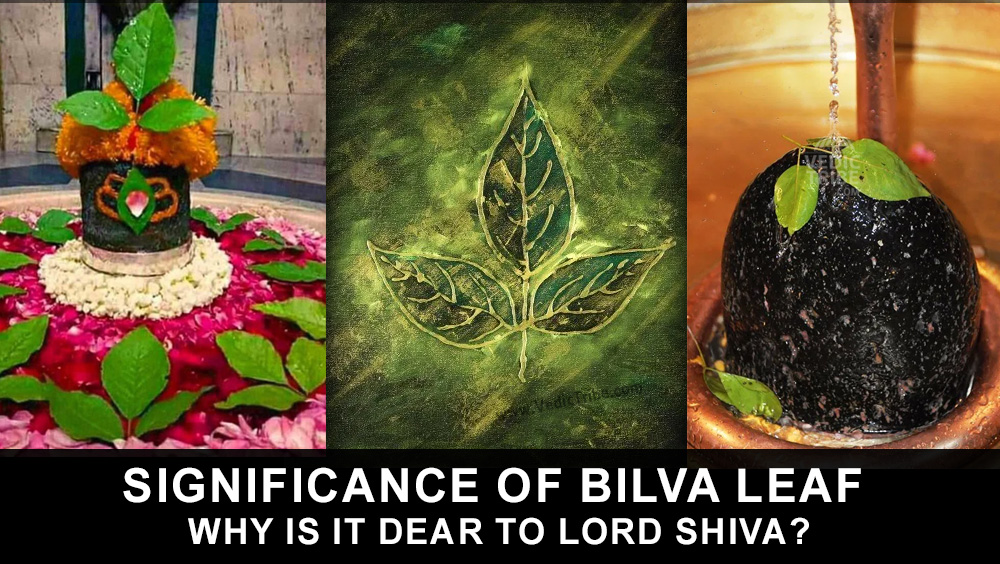
– Arun Gopinath
Hindus believe that the knowledge of medicinal plants is older than history itself, that it was gifted hundreds of thousands of years ago to the Vedic by Lord Brahma, the divine creator.
Thus when the Rishis of the Ayurveda sought to heal human suffering, they were able to draw on knowledge that had already been evolving for millennia in the forests of India. One tree about which they had a very deep knowledge was the Bilva tree. The science of Ayurveda values the Bilva highly for the medicinal properties contained in its root, fruit and leaves. According to Swami Sivananda, it is a healing tree which cures all diseases caused by vata (wind) and gives strength to the body.
More commonly known as the Bel Tree in India as well as other warm countries, this is a sacred tree having sacrificial importance and the first thing we can notice about the leaves is that they are generally trifoliate. This trifoliate leaf is symbolic of Trikaal or the Hindu Trinity of Devas known as Brahma Vishnu and Mahesh. The other names of this tree are Wood apple and its botanical name is Aegle marmilos.
The Bilva leaf or Patra as it is known, represents the Trinetra or three eyes of Lord Shiva, the main aspects like Trishakti (volition, action and knowledge), the three Shiva lingams and the three syllables of AUM or Omkar and are most favorite of Lord Shiva.
There are also five formed Bilva leaves known as PanchaDal patra found on some Bilva trees and these too are held as sacred for the worship of Lord Shiva. Bilva tree grows to a height of 8 meters with thorns. The leaves are alternate, ovate, trifoliate and aromatic. The tender leaves and shoots are consumed as salad greens. The flowers bloom in the month of May and will have a sweet fragrance.
It appears from all the Hindu texts and scriptures that the Bilva tree itself has been held very sacred and auspicious and is considered very holy since time immemorial thats its significance is mentioned in Mahapuranas in various forms of mantras. The Shiva Purana mentions a particular narration of how the usage of Bilva due to its scientific as well as medicinal properties is of great adavantage to Mankind.
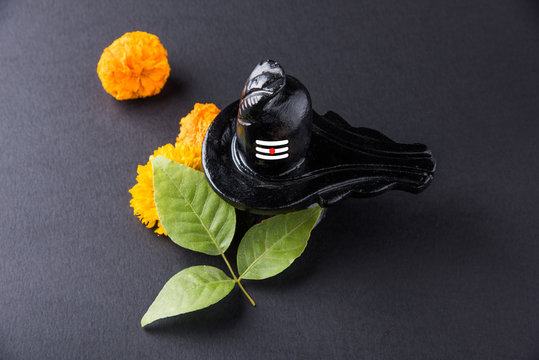
The 22nd Chapter of maha ShivaPurana narrates ” The trifoliate Bilva Patra is so sacred to Lord Shiva & is therefore a symbol of the Lord. Adored by all the Gods, its importance is difficult for anyone to comprehend. The sacred tree can only be known to a limited extent. Sacred sites of this Earth can only find their place at the root of this auspicious tree. Those who meditate upon Lord Mahadeva in His form of linga at the root of Bilva obtain Moksha & become purified souls by attaining Shiva. Such are the marvels of this sacred Bilva.”
The famous Shri Bilvashtakam (v. 6–7) Mentions :
Lakshmyaascha stana utpannam Mahaadeva sadaa priyam,
Bilva vriksham prayachchhaami eka bilvam Shivaarpanam.
Darshanam bilva vrikshasya sparshanam paapanaashanam,
Aghorapaapasamhaaram eka bilvam shivarpanam.
Translation :
Born from the heart of Goddess Lakshmi, the Bilva tree is ever dear to Mahadeva. So I ask this tree to offer one Bilva leaf to Lord Shiva. Even if (one) has darshan ( view) of the Bilva tree, and touches it, surely frees one from sin. The most terrible karma is destroyed when a Bilva leaf is offered to Lord Shiva.
It is also believed that Lakshmi, the Goddess of Wealth, also lives in the bel tree. Those who perform the puja of Shiva and Parvati devoutly, using the leaves, will be endowed with spiritual powers.
Scientific Advantages
According to Hindu scriptures, the Bilva is Triguna which is connected to the three Gunas or components of natural characteristics of the tree. In Hindu philosophy, the three Gunas are Sattva, Rajas & Tamas with Sattva being the pure most while Tamas normally is to do with darkness & ignorance.
The Sattvic component is believed to be more centered within the bilva patra and therefore the high capacity to absorb and emit Sattvic frequencies. This has various effects on the environment as well as on anyone merelt touching the leaf. One of them is the reduction of Rajasic-Tamasic atoms present in the atmosphere & more importantly within the human body.
A Sattvic leaf like bilva patra when brought in proximity of a person suffering from negative energies such as distress and anxiety is believed to medically reduce these energies within the human body. People with negative outlook towards life and their environment normally do not realize they have negative energies building up within their body and are at a risk of subconsciously harpering destructive thoughts also.
Whenever such people come into contact with a Sattvic atmosphere, what they fail to realize is their negative energies try to fight the positivity of a Sattva predominant environment. This struggle can build up at various levels and can vary from the human mind thinking negatively and can result sudden bursts of anger to destruction of things around them.
Medicinal uses
The roots, skin, fruits and the leaves of the Bilva tree are used for medicinal purpose. Bilva has astringent, edema lessening, anti-diarrhea, laxative and appetizer properties hence, can be used to cure both internal and external diseases.
The sacred tree has many medicinal usages and is advantageous in curing many human ailments such as :
- Bleeding gums.
- Bel fruit clears diarrhea, dysentry, phlegm, high blood pressure, morning sickness in pregnancy, stress.
- Asthma can be controlled when a mixture of dry bel leaf powder & honey is consumed daily
- Jaundice can be cured by consuming the extracted juice of the bilva leaves
- Anemia can be cured by drinking the powder of the bel fruit mixed with milk
- Bel fruit keeps the skin rejuvenated when pasted into a face pack; also cures joint aches
Hinduism
Concept of Time and Creation (‘Brahma Srishti’) in Padma Purana
Published
5 years agoon
March 12, 2021By
Vedic Tribe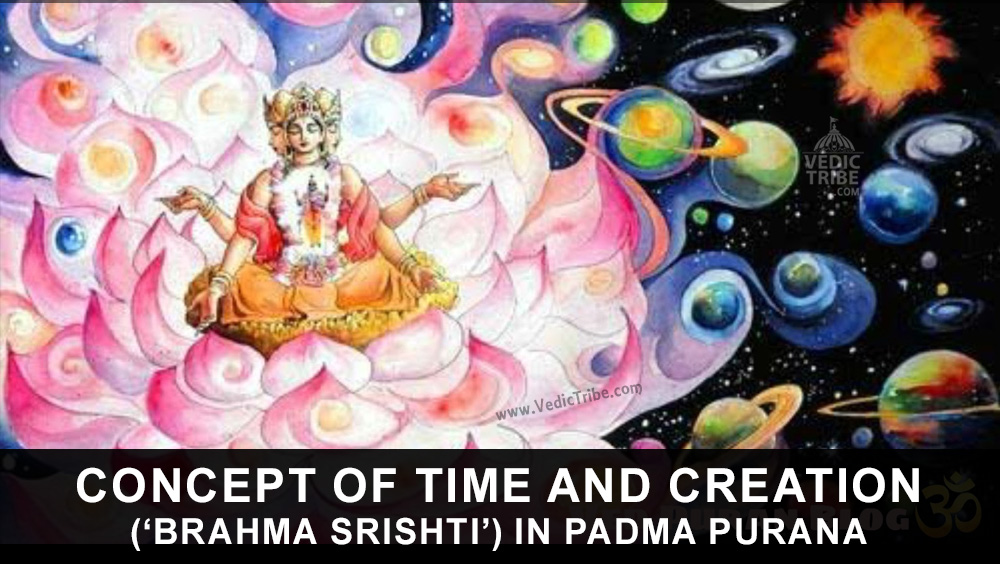
Pulastya Maha Muni affirmed to Bhishma that Brahma was Narayana Himself and that in reality he was Eternal. But in a formal sense it was stated that Brahma was ‘created’ and in that normally recognised manner Brahma had hundred years of age; apparently, the concept of Time would have to have a basis and that was why Brahma’s age was determined notionally as of hundred Brahma Years; in other words, ‘Para’or the first half was over and his present age has entered the ‘Paraartha’, the second half (viz. Fifty first year).This was how, the concept of Time emerged.
Every fifteen ‘Nimeshas’ constitute one ‘Kaashtha’; thirty Kashthas one one ‘Kala’; thirty Kalas make one ‘Muhurtha’; thirty Muhurtas make one day/night, thirty day/nights make on ‘Maasa’; (half Maasa makes one ‘Paksha’), six Maasas make one ‘Ayana’ and two Ayanas-Dakshinayana and Uttarayana- make one ‘Year’. Dakshinayana is a night for Devas and Uttarayana their day. One hundred human years make one day-night of Devas.
Twelve thousand Deva Years make four Yugas viz, Satya Yuga, Treta Yuja, Dwapara Yuga and Kali Yuga and these four Yugas make one Maha Yuga which is Brahma’s one day! Satya Yuga comprises 4800 DevaYears including ‘Sandhya mana’ of 400 years and ‘Sandhyamsha maana of additional 400 years; Treta Yuga comprises 3600 Deva Years including 600 years of ‘Sandhya/ Sandhyamsha mana’each; Dwapara Yuga of 2400 years including 200 years of ‘Sandhya/ Sandhyamsha mana’each and Kali Yuga of 1000 years including 100 years each of Sandhya / Sandhyamsha manas.Deva Years are 360 times more than human years. For instance, the duration of Kali Yuga in human year terms is 432,000 years; Dwapara’s is 864000; Treta Yuga’s is12, 96,000 and of Satya Yuga is 17, 28,000 years; all the Yugas totalling 432, 00, 00,000 (432 million) make one Chaturyuga and that constitutes one Brahma Day!
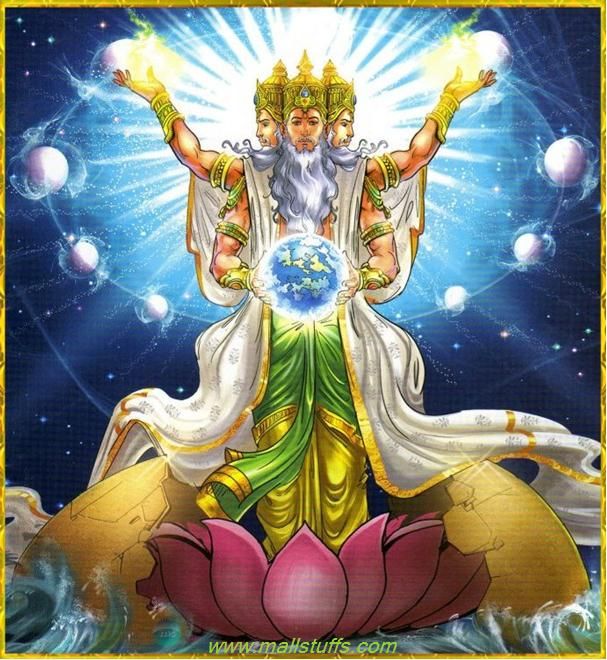
In one day of Brahma there are fourteen Manvantaras and each Manvantara has 8, 51,000 of Deva Years. There are two kalpas on one day-night of Brahma.At the end of the previous Kalpa, Brahma felt fresh from the previous night and found that Prithvi was submerged in water while Bhagavan Varaha Deva entered into water and Prithvi prayed to him; in response, Varahadeva emanated a ‘Ghur Ghur’ sound which was like the reverberation of Sama Veda, lifted up Prithvi from Rasala loka by the might of his horns, Devas rained fragrant flowers from the sky, Rishis went into rapturous tributes to Vishnu’s incarnated Varaha Rupa; and Brahma implored the latter to allow him recommence Srishti with his blessings as also to preserve and administer the Creation that he would so generate even as the Lord gracefully replied to say: ‘Tathastu!’ (So be it!).
Brahma’s first Srishti being Maha Tatva, the creation of Tanmatras was known as Bhuta Sarga or the Second Srishti; Vaikarika or Satvika Ahankara was the third Srishti of Indriyas or Aindriya Sarga; the Fourth Srishti is the Mukyha Sarga related to Mountains, Forests and other Sthaavara Srishti; the fifth Srishti relates to Pashu-Pakshi (Animals and Birds); the seventh Srishti was called Deva sarga or Urthva faced and was of Devas; and Seventh Srishti was of Manava Sarga; the Eighth was of Anugraha Sarga which could be of Satvika or Tamasic nature and finally the Ninth Srishti called the Kaumara Sarga which could be of Prakrita or Vaikrita Marg.
Depending on the carry forward of one’s own balance of ‘Papa-Punya’of the previous time-frame preceding the Pralaya, placement of lives was commenced by Brahma in the New Age. Arising out of his ‘Manasika Samkalpa’ (Mind born Proposal), Brahma created various species including Devas, Asuras, Pitaras and human beings. From his thighs, the evil Asuras emerged and as per his free will various birds were created.
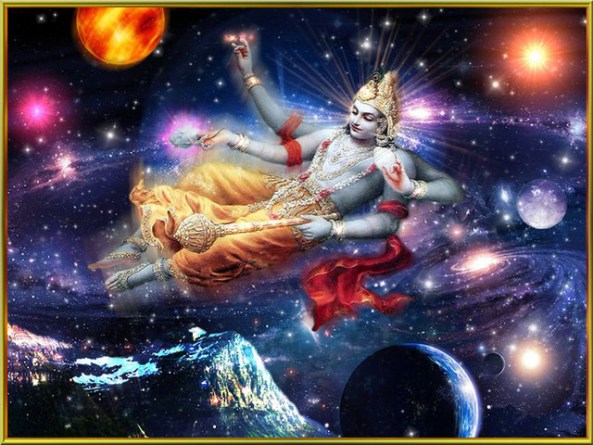
From his stomach surfaced cows, his shoulders the wolves; his face created horses, elephants, asses, nilgais, deer, camels, etc.each species multiplying several others. Brahma’s body hairs created fruits, roots and foodgrains. From his right extreme face, Brahma created, Gayatri Chhandah, Rig Veda, Tivritstoma, Rathantara, Agnihoshtha yagna; from South-faced he created Yajur Veda, Tristhub Chandas, Panchadasha stoma, Brihatsaama, etc; Sama Veda, Jagati Chhanda, Saptadashastoma, ‘Vairupa’ etc; from the Western face; Brahma created Ekavimshatstoma, Atharva Veda, Aptoryama, Anushthup chhanda, and Vairaja from the Uttaravarti Mukha. Miscellaneous ‘Pranis’ were created from any of the limbs of Brahma. To sum up thus at the beginning of the Kalpa, Prajapati Brahma created Devas, Asuras, Pitaras and human beings as also of Yakshas, Pishachas, Gandharvas, Apsaras, Siddhas, Kinnaras, Raakshasaas, Lions, Birds, Animals and Reptiles.
Focussing attention on human beings now, Bhishma asked the highlights of Varnashrama Vidhi and Pulastya Muni explained that Brahma created Brahmanas from the face, Kshatriyas from ‘Vakshasthali’ (chest), Vaishyas from thighs; and Shudras from the feet.These four Varnas are the important constituents of ‘Yagnas’; Devas are satisfied wirh their respective portions of ‘Havis’ (oblations) to Agni and being pleased with the Yagnas, Devas bestow good rains and good crops which leads to material prosperity.
The hearts and hands of every body tend to be clean and social customs and virtuous living would go hand in hand. Prajapati decided the duties of the Four Varnas, depending on the professions that human beings tended to follow like Brahmanas performing Yagnas, Vratas, Temple Tasks, and enabling various religious deeds of Virtue in favour of the members of three other Varnas etc.; Kshatriyas discharging the responsibilities of Kingship, Administration, Security against external enemies, collection of taxes and maintenance of Internal Law and Order; Vaishyas performing business, farming, trading and all matters involving finance, provision of materials to others by allowing reasonable profits for the services given etc. and Shudras supporting the members of the Three Varnas in the discharge of duties being undertaken by them.
Brahma materialised the above various kinds of Creations by applying his mental faculties but was not quite satisfied as the next generations so created were not adequate to fill in the universe; therefore he created Sages like Bhrigu, Pulaha, Kratu, Angira, Marichi, Daksha, Atri and Vasishtha, in addition to the four ‘Manasa Putras’ viz. Sanaka, Sanandana, Sanatana and Sanat Kumaras. As not all these sons were interested in family lives, Brahma created Rudra from his forehead and decided that half of the body be a woman; thus Eleven Rudras got materialised along with as many Rudranis who had a variety of Rupas ranging from ‘Sowmya’ (composure), ‘Krura’(unkindness), ‘Shanta’ (peacefulness), ‘Shyama’ (darkness), ‘Gaura’ (wheatish) and such other colours.
Further on, Brahma created Swayambhu Manu and the latter’s wife Shatarupa; the Manu couple gave birth to sons Priyavrata and Uttanapada and daughters Prasuti (married to Daksha) and Akruti (married to Ruchi Prajapati). To Prasuti and Daksha were born twenty four daughters, thirteen of whom were Shraddha, Lakshmi, Dhruti, Pushti, Tushti, Megha, Kriya, Buddhi, Lajja, Vapu, Shanti, Sidhi, and Kirthi (all these thirteen were married to Dharma); eleven more daughters were Khyati, Sati, Sambhuti, Smriti, Preeti, Kshama, Sannati, Anasuya, Urja, Swaha and Swadha; they were wedded respectively to Bhrigu, Shiva, Marichi, Angira, Pusasthya, Kratu, Atri, Vasishtha, Agni and Pitras.
The sons of Daksha’s daughters were Kamak by Shraddha, Darpa to Lakshmi, Niyam to Dhriti, Santhosh to Tushti, Lobha to Pushti, Shruta to Megha; Danda, Vinay and Naya to Kriya, Bodha to Buddhi, Vinay to Lajja, Vyavasayak to Vapu, Kshema to Shanti, Sukha to Siddhi, and Yash to Kirti.These were all the sons of Dharma. Kaam and Nandi gave birth to Harsha, the grand son of Dharma. Bhrigu and Khyati gave birth to Devi Lakshmi who was Lord Narayana’s wife. Bhagavan Rudra accepted Sati as his wife (Daksha’s daughter) but Devi Sati sacrificed her life pursuant to Daksha’s Yagna to which Rudra was uninvited but Sati insisted in attending it; she felt highly insulted by her father Daksha who also offended Rudra Deva and Rudra eventually destroyed Daksha Yagna. — with Srilan Srisukumaran.
Hinduism
Karma Yoga – Yog Through Selfless Actions
Published
5 years agoon
February 23, 2021By
Vedic Tribe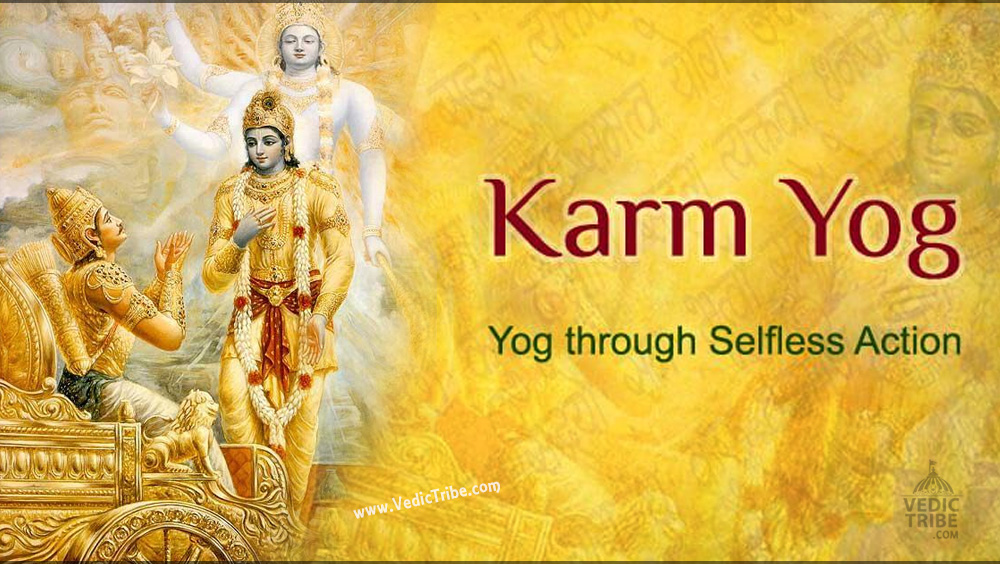
Karma Yoga is Meditation in Action:
“Karma” means action and “yoga” means loving unity of our mind with God. To perform karma and also practice yoga means to remain engaged in activity in the world while remaining in a state of devotional unity with God. This is true spiritual action.
Your bhakti yoga meditation practice will combine all these aspects and it will include:
- Daily sitting meditation
- Daily dynamic meditation woven seamlessly into the fabric of your life’s activities
Before we look at guidelines for these, let’s explore how process is described in the Hindu scriptures.
Karma Yoga of the Bhagavad Gita:
One of the most important scriptures of Hinduism, the Bhagavad Gita, was revealed under unusual circumstances: moments before a war and in the middle of a battlefield. It is comprised of a 700-verse dialogue between Lord Krishna, supreme God, and Arjuna, his loving disciple.
The all-in-one solution of the Bhagavad Gita for eliminating karma is Lord Krishna’s advice to practice akarma or actions that have no karmic consequence.
If we could perfect akarma in daily activity, the consequences of our actions would automatically be neutralized — even though we are engaged in action.
This means that from the point of view of karmic debt, no consequences would be added to our “account”. The only key to this is we must maintain an unbroken and continuous devotion to God.

Karma yoga philosophy in the Bhagavad Gita is summed up in one statement of Lord Krishna:
“Remember Me and fight.”
But is it really possible to simultaneously do devotional remembrance and be engaged in activity? Can the mind function in two places at the same time? This is definitely impossible, but for karma yoga to be done properly, both have to happen simultaneously.
For example, if you are at work and absorbed in a project, and remember God occasionally, how are both these actions accounted for as karmas?
The time you spent in devotional remembrance will be considered devotional action, and the time you spent engrossed in working will be considered normal action. This is not karma yoga.
Plus, a common misconception describes karma yoga as “performing action without being attached to the results”. Although this sounds noble, is it psychologically possible for any human being to do this?
The fact is because we are constantly trying to find authentic happiness, we will always anticipate the outcome of our actions in advance of doing them.
The practical form of the Gita’s karma yoga…
In the Gita, Krishna was both supreme God and Arjuna’s spiritual guide. Krishna advised Arjuna to surrender to Him and to simply follow His instructions. By transferring his motivation for action to a divine personality, Arjuna would not be responsible for the outcome of the actions he was instructed to perform.
For example, a police officer is issued a revolver, which he is instructed to use in the line of duty by his superiors. It could happen that he kills someone in the pursuit of law and order. In the eyes of the justice system, this will not be considered a crime. He did not use his own mental motivation to decide to kill someone — he simply followed the guidelines given to him by his superiors.
In Arjuna’s situation, in spite of engaging in war, all his actions were counted as devotion, because his heart, mind and body were fully dedicated to the will of Krishna.
This again highlights one of the most important points of karma yoga: The mind is the performer of action, not the physical body.
It is our personal motive that has to be carefully redirected for karmic consequences to change or be neutralized.

A Closer Look at the Spiritual Theory
If a practitioner is surrendered to a true divine Guru, and performs actions entrusted to him by his Guru, that activity is considered not only karma yoga, but also bhakti or spiritual action. It will be free of a karmic consequence. That practitioner is not directly attached to the results of that activity because his motive is to follow the instructions of his Guru.
Arjuna accepted Lord Krishn as his Guru at the very beginning of the Gita when he declared he was Lord Krishna’s disciple. He preserved the understanding during the entire Mahabharata War that he was doing service for his Guru.
In this way, just by holding this intention, his devotion remained unbroken and his actions were considered karma yoga. Thus, service to a true Guru is called karma yoga or devotion.
Practically speaking, a Guru will give instructions on how a practitioner can keep his mind engrossed in a state of continuous devotional remembrance. Simply by following these instructions, a disciple is automatically practicing karma yoga.
Those devotional guidelines take the form of (1) karma sanyas and (2) karma yoga.
Karma Sanyas – Quiet Time for Meditation
And old method of dyeing fabric in India was to place a cloth in a dye bath and then allow it to dry in the sun.
After drying, the intensity of the color faded. Again the cloth was placed in a dye bath, again it was placed in the sun, and again the color faded, but the second time more of the color remained.
After entering the dye bath multiple times, the color eventually became intense and fixed.
Similarly, to establish devotion in our hearts and minds, it is important to have a structured daily practice of sitting meditation.
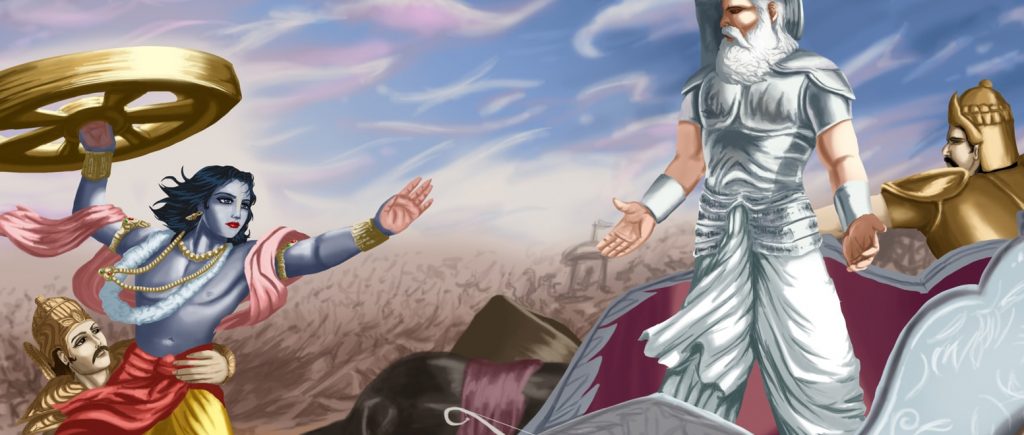
The main elements of a daily devotional practice include:
- Heart-centered prayer
- Kirtan or chanting meditation combined with active visualization
- Aarti-the offering of light – a brief ceremony that reaffirms the spirit of our devotional dedication
Karma Yoga – Dynamic Devotion
For the attainment of divine love, the Vedas state that there is only one rule and one prohibition that apply to bhakti yoga meditation. The rule is: “Always remember Radha Krishna.” The prohibition is, “Never forget Radha Krishna.”
This means that after our sitting meditation, our meditation should continue — while eating, sleeping, walking, working, talking, resting, and so on.
Wherever you are, all the time, whatever you are doing, remember your divine beloved and don’t forget Him! This simultaneous devotion and action is karma yoga. This state of devotional consciousness is cultivated over time with practice.
For example, in the old days street musicians with hand organs kept small monkeys. A monkey by nature is extremely active. How to make a monkey’s nature conform to sitting still, and that, too, in a confined space?

The musician’s technique was to first restrain the monkey with a 100-foot rope. If the monkey tried to go outside of this range, he was stopped. He thought, “Okay, I’ll jump around in a 100-foot area.”
When he was tied with a 50-foot rope he thought, “I went 100 feet yesterday, today I’m restricted to this much.” So he jumped around in a 50-foot area.
When the monkey was finally limited to only 1 foot of rope, he sat quietly, “Why should I drive myself crazy? I’ll just sit here.”
The human mind has this same monkey-like nature. It roams far and wide. Our goal is not to tame it’s active nature, but to train it to roam in a particular area. This is done by gently tying it with the devotional rope of love.
In sitting meditation we cultivate a feeling a devotional relationship with God. In active meditation we can continue this in three ways:
- Embed your intention — Every person has a mission that guides his life’s activities. For example, very few people like to work, but they do it because their mission is to support themselves or their family. While they are at work, although this motive is hidden deep in their mind, it still guides their decisions and actions.Similarly, when we firmly understand the purpose of our life is God-realization, this intention deeply embeds itself in the mind. If cultivated properly, this subconscious devotional intention remains in all our activities, even when we are sleeping.
- Feel divine presence — in sitting meditation we visualize and feel our relationship to God’s personal form. In activity, take hourly breaks for 30 seconds or a minute and with open eyes sense the presence of your worshipped form of God or Radha Krishna. Simply feel you are not alone. Imagine them near or far, sitting, standing or in any position, in any mood of love.
- Share your awareness — After visualizing God’s presence, either feel He is watching you or that you are showing Him what you are doing.
- Avoid wrong association — your associations and environment will affect your feeling of divine connection. Be mindful and avoid those situations that divert your devotional intention.
There is no restriction of time, place and activity for this remembrance. It can be done anywhere, at any time. You do not need to sit in a particular position or have closed eyes. This very simple practice will recall the blissful feelings of your seated meditation and help to stabilize your devotional experience.
Follow us on Facebook
Follow us on Twitter
Latest


Seven Vows and Steps (pheras) of Hindu Wedding explained
Views: 9,186 Indian marriages are well renowned around the world for all the rituals and events forming part of the...


Sari or Saree is symbol of Indian feminism and culture
Views: 7,416 One of the most sensual attires of a woman in India is undoubtedly the sari. It is a...


Atithi Devo Bhava meaning in Hinduism and India
Views: 7,184 Atithi Devo Bhava, an ancient line taken from the Hindu scriptures and was originally coined to depict a visiting person whose...


Sanskrit Is More Than Just A Method To Communicate
Views: 5,387 -By Ojaswita Krishnaa Chaturvedi anskrit is the language of ancient India, the earliest compilation of sound, syllables and...


Significance of Baisakhi / Vaisakhi
Views: 6,608 Baiskhi is also spelled ‘Vaisakhi’, and is a vibrant Festival considered to be an extremely important festival in...


Navaratri: The Nine Divine Nights of Maa Durga!
Views: 7,712 – Shri Gyan Rajhans Navratri or the nine holy days are auspicious days of the lunar calendar according...


History of Vastu Shastra
Views: 10,926 Vastu Shastra (or short just Vastu) is the Indian science of space and architecture and how we may...


Significance of Bilva Leaf – Why is it dear to Lord shiva?
Views: 10,557 – Arun Gopinath Hindus believe that the knowledge of medicinal plants is older than history itself, that it...


Concept of Time and Creation (‘Brahma Srishti’) in Padma Purana
Views: 10,836 Pulastya Maha Muni affirmed to Bhishma that Brahma was Narayana Himself and that in reality he was Eternal....


Karma Yoga – Yog Through Selfless Actions
Views: 9,712 Karma Yoga is Meditation in Action: “Karma” means action and “yoga” means loving unity of our mind with...

